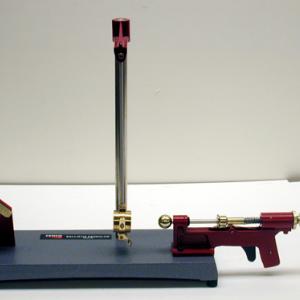College of Liberal Arts & Sciences
1M40.41 - Ballistic Pendulum
Make sure the CENCO unit is oiled and swinging freely. It is also important that this is set level or the ball will not catch in the swinging carriage.
A more dramatic demonstration of the ballistic pendulum is to use the vacuum cannon as a projectile launcher, and the 1 kg catcher box. Position the vacuum accelerator so that there is very little space between that and the front of the catch block. Position the sonic sensor so that it is about 40 cm away from the flat back side of the catch block. The sonic sensor will measure the maximum deflection of the catch box after it catches the ball (this is usually about 22 cm). The ping pong balls mass is about 2.6 grams so with these figures you should be able to calculate the speed of the projectile.
- J. P. Polley, "An Inexpensive Apparatus to Study Conservation of Angular Momentum in the Introductory Laboratory", TPT, Vol. 59, #6, Sept. 2021, p. 426.
- James C. Sanders, " A Ballistic Pendulum with Varied Launch Speed", TPT, Vol. 58, #9, Dec. 2020, p. 632.
- David Schultz, "An Inexpensive, Multi-Purpose Physical Pendulum", TPT, Vol. 50, #7, Oct. 2012, p. 436.
- Dean Baird, "The Blowgun as a Teaching Tool", TPT, Vol. 34, #2, Feb. 1996, p. 98.
- Thomas B. Greenslade Jr., "Nineteenth‐Century Textbook Illustrations—L", TPT, Vol. 29, #6, Sept. 1991, p. 415.
- Robert K. F. Keefer, "So What Else Can You Do with a Ballistic Pendulum?", TPT, Vol. 28, #7, Oct. 1990, p. 495.
- John W. Zwart, "A Safe and Inexpensive Ballistic Pendulum", TPT, Vol. 25, #7, Oct. 1987, p. 447.
- Tom Sandin, "More About Pendulums", TPT, Vol. 22, #5, May 1984, p. 340.
- John G. McCaslin, "A Different Blackwood Pendulum Experiment", TPT, Vol. 22, #3, Mar. 1984, p. 184.
- Mario Iona, "Length of a Ballistic Pendulum", TPT, Vol. 12, #3, Mar. 1974, p. 133.
- Carl E. Scheie, "Ballistic Pendulum", TPT, Vol. 11, #7, Oct. 1973, p. 426.
- Denis Donnelly and Joshua B. Diamond, "Slow Collisions in the Ballistic Pendulum: A Computational Study", AJP, Vol. 71, #6, June 2003, p. 535.
- P. D. Gupta, "Blackwood Pendulum Experiment and the Conservation of Linear Momentum", AJP, Vol. 53, #3, Mar. 1985, p. 267.
- F. C. Peterson, "Timing the Flight of the Projectile in the Classical Ballistic Pendulum Experiment", AJP, Vol. 51, #7, July 1983, p. 602.
- Glen E. Everett and R. L. Wild, "Inexpensive Time-of-Flight Velocity Measurements", AJP, Vol. 47, #5, May 1979, p. 426.
- Enos Wicher, "Ballistic Pendulum", AJP, Vol. 45, #7, July 1977, p. 681.
- A. Sachs, "Blackwood Pendulum Experiment Revisited", AJP, Vol. 44, #2, Feb. 1976, p. 182.
- Robert L. Alt, "A Corrupted Ballistic Pendulum", AJP, Vol. 40, #11, Nov. 1972, p. 1688.
- Guenter Schwarz, L. T. Bayliss, and C. F. Ffolliott, "Using a Blowgun with the Ballistic Pendulum", AJP, Vol. 36, #6, June 1968, p. 558.
- R. W. Barton, "A Versatile Ballistic Pendulum", AJP, Vol. 32, #3, Mar. 1964, p. 229.
- Hans Weltin, "Vertical Ballistic Pendulum Apparatus", AJP, Vol. 31, #9, Sept. 1963, p. 719.
- William Gurstelle, "How To Build A Ballistics Box That Measures Fastballs", Popular Science, Vol. 287, #3, Sept. 2015, p. 70.
- G. D. Freier and F. J. Anderson, "Mi- 3", A Demonstration Handbook For Physics.
- David Kutliroff, "60, Converting Potential to Kinetic Energy", 101 Classroom Demonstrations and Experiments For Physics Teachers, p. 134.
- D. Colson, C. J. Lapp, J. A. Eldridge, "Experiment XI", 1936 Univ. of Iowa Physics Laboratory Manual, p. 21.
Disclaimer: These demonstrations are provided only for illustrative use by persons affiliated with The University of Iowa and only under the direction of a trained instructor or physicist. The University of Iowa is not responsible for demonstrations performed by those using their own equipment or who choose to use this reference material for their own purpose. The demonstrations included here are within the public domain and can be found in materials contained in libraries, bookstores, and through electronic sources. Performing all or any portion of any of these demonstrations, with or without revisions not depicted here entails inherent risks. These risks include, without limitation, bodily injury (and possibly death), including risks to health that may be temporary or permanent and that may exacerbate a pre-existing medical condition; and property loss or damage. Anyone performing any part of these demonstrations, even with revisions, knowingly and voluntarily assumes all risks associated with them.
